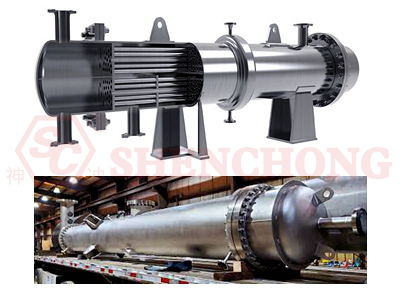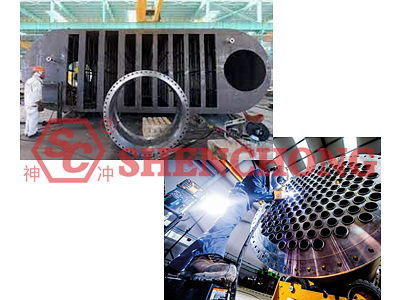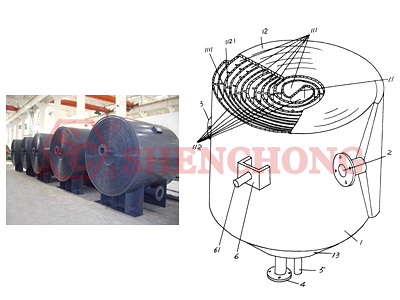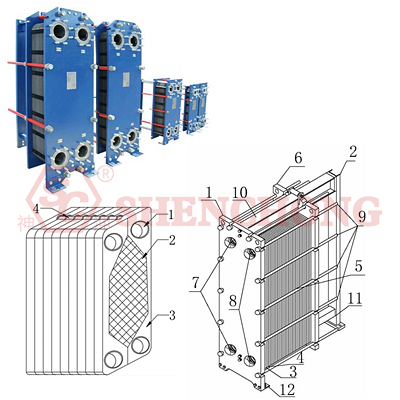
A heat exchanger is a device that transfers part of the heat from a hot fluid to a cold fluid. Heat exchangers play an important role in chemical, petroleum, power, food, and many other industrial production. In chemical production, heat exchangers can serve as heaters, coolers, condensers, evaporators, and reboilers.

A heat exchanger is an energy-saving device that achieves heat transfer between materials between two or more fluids at different temperatures. It is to transfer heat from a fluid with a higher temperature to a fluid with a lower temperature, so that the fluid temperature reaches the specified indicators in the process to meet the needs of process conditions. It is also one of the main equipment for improving energy utilization efficiency.
The heat exchanger industry involves nearly 30 industries such as HVAC, pressure vessels, reclaimed water treatment equipment, chemical engineering, and petroleum. Mutual formation of industrial chains.

- First, select the manufacturing materials and brands of heat exchange equipment.
- Conduct chemical composition testing of materials.
- After the mechanical properties are qualified, the steel plate is corrected.
Methods include: manual orthotics, mechanical orthotics and flame orthotics.
- Manufacturing process:
Material preparation → marking → cutting → edge processing → forming → assembly → welding → welding quality inspection → assembling welded parts → pressure test quality inspection
Not only are raw materials inspected before manufacturing, but they are also inspected at any time during the manufacturing process.
- Specific equipment used:
Welding machines, beveling machines, pipe bending machines, elbow heat treatment furnaces, hydraulic press machine, large plate shearing machines, plate bending machines, plate rolling machines, etc.
The structural types of heat exchangers suitable for different media, different working conditions, different temperatures, and different pressures are also different.
The specific classification of heat exchangers is as follows:
- Partitioning wall heat exchanger
- Regenerative heat exchanger
- Fluid connection indirect heat exchanger
- Direct contact heat exchanger, also known as hybrid heat exchanger
- Compound heat exchanger
- Heater: Heats the fluid to the necessary temperature without causing a phase change in the heated fluid.
- Preheater: Preheats the fluid to provide standard process parameters for process operations.
- Superheater: Heating the fluid (process gas or steam) to a superheated state.
- Evaporator steaming: heating the fluid to a temperature above the boiling point, causing the fluid to evaporate, usually with a phase change.
- Floating head heat exchanger
- Fixed tube plate heat exchanger
- U-shaped tube sheet heat exchanger
- Plate heat exchanger
The spiral plate heat exchanger is made of two parallel metal plates rolled into two spiral channels. A heat exchanger that exchanges heat between hot and cold fluids through spiral plate walls. Spiral plate heat exchangers are available in detachable and non-detachable types.
The spiral plate heat exchanger has the advantages of small size, compact equipment, high heat transfer efficiency and low metal consumption. It is suitable for dry liquid-liquid, gas-liquid, gas-gas convection heat transfer, steam condensation and liquid evaporation heat transfer, chemical industry, petroleum, medicine, machinery, electric power, environmental protection, energy saving and industries requiring heat conversion.

The spiral heat exchanger is rolled from two sheets to form two uniform spiral channels. The two heat transfer media can flow in full countercurrent, which greatly enhances the heat exchange effect. Even two mediums with small temperature differences can achieve ideal heat exchange effects.
Blanking, splicing → non-destructive testing → flanging, contact welding distance columns → surface cleaning → assembly → non-destructive testing → plate rolling machine → channel shaping, welding channel, assembly → metal processing → assembly → pressure test → pickling and passivation → packaging.
End cover blanking (profiling cutting) - assembly (ring ribs, inverted cones) - laminating composite panels - non-destructive testing - metal processing - leak detection - post-processing - painting.
The shell of the spiral plate heat exchanger is a connection structure that can withstand internal or external pressure. To improve the pressure-bearing capacity of the shell, the spiral plate heat exchanger shell is welded by a combination of two semi-cylinders. The key component of this combination welding is the connecting plate.
The connection between the connecting plate, the spiral plate and the shell is to place the connecting plate on the spiral body, weld both sides, and then weld the two semicircular shells to the connecting plate. The welded structure adopts butt welds with lining plates to ensure the welding quality of the butt welds.
The spiral body is an elastic body, such an elastic member. When it is put under pressure, it is easily crushed, making the equipment unable to operate normally. One way is to increase the spiral plate thickness, which is uneconomical. Another way is to increase the number of spaced columns and reduce the distance between spaced columns. This is used to improve the stiffness and pressure-bearing capacity of the spiral plate.
There are two methods of using fixed distance column welding. One is to use manual welding to weld the distance columns to the ten-helix body. Another method is to use contact welding technology (stud welding) for the distance columns, which contact welds the distance columns.
The plate heat exchanger is composed of stamped concave convex stainless steel plates. The concave and convex patterns between the two adjacent plates form a 180 degree relative combination. Therefore, the concave and convex ridges between the two plates of the plate heat exchanger form intersecting contact points. After combining the contact points through vacuum welding, a high-pressure staggered flow structure of the plate heat exchanger is formed. These staggered flow structures generate strong turbulence in the cold and hot fluids inside the plate heat exchanger, achieving high heat transfer efficiency.
A plate heat exchanger is composed of a set of corrugated metal plates. There are four corner holes on the board for the passage of two types of liquid for heat transfer. The metal plate is installed in a frame with a fixed plate and a movable compression plate on the side, and is clamped with clamping bolts. The plates are equipped with sealing gaskets to seal the fluid channels and guide the fluid to flow alternately into their respective channels, forming heat exchange.
The flow rate, physical properties, pressure drop, and temperature difference of the fluid determine the number and size of the plates. The corrugated plate not only increases the level of turbulence, but also forms many support points that are sufficient to withstand the pressure difference between the media. The metal plate and movable plate pressing plate are suspended on the upper guide rod and positioned by the lower guide rod, while the rod end is fixed on the support column.

Firstly, start with a flat sheet of raw material for the board. Raw material manufacturers are also divided into brands, thicknesses, and standards. When the raw materials arrive at the plate heat exchanger manufacturer, the surface quality and material of the plate material must be inspected for storage.
Then cut the board according to the size of the target processing board. Cut off excess leftover materials. During the cutting process, the surface of the cut should be inspected to ensure that there are no burrs, curls, or other issues. At the same time, the dimensions after cutting should also be checked to ensure accuracy. Purchasing high-precision CNC shearing machines can effectively improve your cutting efficiency!
After cutting the flat material, it is necessary to perform bagging or oiling operations based on the material of the plate. The purpose is to ensure that the thinning amount meets relevant regulations during the pressing process. Ensure that there are no issues such as excessive deformation causing leakage during the use of the board.
Then proceed with the pressing plate. The quality of the pressing plate has a high requirement for the accuracy of the mold. The quality of the plates formed by high-precision and high-pressure hydraulic presses can only be guaranteed.
At the same time, for the pressed plates, penetration testing is also required to ensure that there are no invisible cracks that may cause quality problems. At the same time, the specific size, groove depth, etc. of the pressed plates should be inspected to control the quality of the plates.
After pressing, it is necessary to perform punching operations on the corner holes of the plate. At the same time, according to the design requirements of different heat exchangers such as the first version, blind plate, and special version, the punching positions are also different. Some boards are punched with three holes. Some boards are punched with a hole.
The plates with different number of corner holes can be combined to form a heat exchanger with multiple processes. For some special working conditions, it can not only improve economic benefits but also achieve good heat exchange effects.